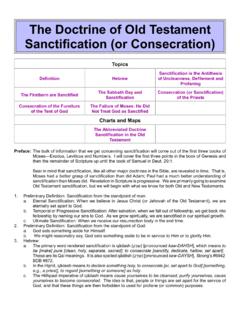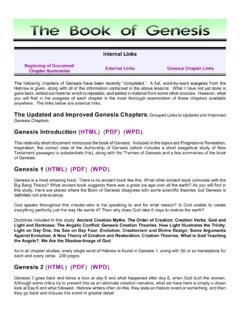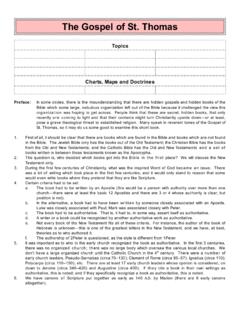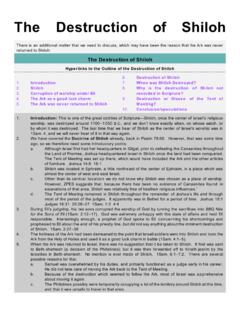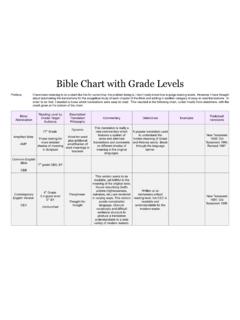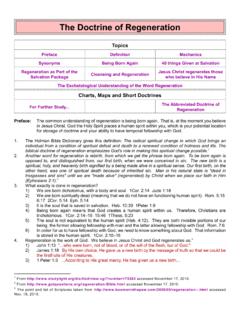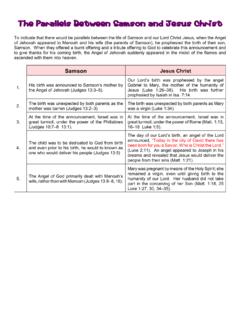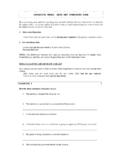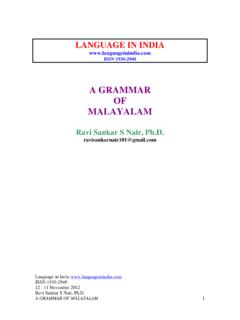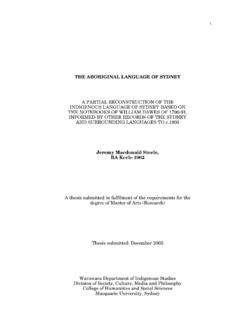Transcription of Hebrew Verbs for Dummies - Kukis
1 Hebrew Verbs for DummiesNote: in my exegesis, the meanings have been modified to match the verb stem used. Sometimes themeanings have been modified to reflect the participle or the imperative mood; sometimes not. Sometimes the meanings of nouns are modified to match whether they are singular or plural; andsometimes not. Extended and much more detailed explanations can be found under Hebrew Grammar for Dummies (or,the PDF version). This will include more extensive footnotes as well. Some of the stems below are equivalent, but used by different authors. Some of the stems haveequivalent uses, but indicate a different formation made upon the original verb .
2 Hebrew StemsThe ParticipleVerb States (or verb Forms) Hebrew TensesHebrew StemsStemUsage/Additional Information HiphilCausative of the Qal stem of a verb . The subject causes the action of the verb , butdoes not directly perform the act. In many instances, we can simply take the Qalform of a verb and precede it with to cause to; to make to. For instance, Davidreigned over Israel (Qal stem with David as the subject of the verb ); God causedDavid to reign over Israel (Hiphil stem of the same verb with God as the subject). The Hiphil is not necessarily always cumbersome to translate; she caused him toeat could also be translated, she fed him.
3 Although we may understand this, in theEnglish, to be the result of compulsion; in the Hebrew , the concept could be moresubtle, such as making something possible to do or the granting of permission to doa thing. The Hiphil form is found approximately of the time in Scripture. 12 Hithpael(1) Reflexive of the Piel (intensive) stem. According to BDB: a) This form primarilyexpresses a "reflexive" action of Qal or Piel, , he wore versus he dressedhimself; he washed versus he washed himself; he fell versus he flung himself; hesold versus he sold himself; I hide, I conceal [something]; versus I hide myself.
4 (2) This can be used in a reciprocal sense: they spoke [with one another] asopposed to simply they spoke. Other examples: they saw they looked upon oneanother they whispered they whispered one to another. (3) Iterative sense: hewalks about; he walks to and fro. Zodhiates adds that this stem can also have apassive meaning, in which the verb acts upon the subject (not mentioned by Seow). (4) Some Verbs in Hithpael are translated as a simple action. The reflexive actionos understood. he prayed, he mourned, he became angry. This form accounts of the Verbs parsed.
5 3 The Complete Word Study Old Testament; Dr. S. Zodhiates; 1994 AMG Publishers; p. According to 2 accessed September 19, 2009. Choon-Leong Seow, A Grammar for Biblical Hebrew (Revised Edition); Abingdon Press, Nashville; 1995, p. 298. Also taken3from #h8804 accessed September 19, 2009. StemUsage/Additional Information Hithpalal,Hithpalel,Hithpalpel,Hithpoel, HithpolelReflexive of the Piel (intensive) stem. These differ from the Hithpael only in form,but they affect the verb in the same way. Some authors do not treat these asseparate forms, but simply lump them together with the Hithpael.
6 Some authorssimply use slightly different names ( , Gesenius uses the term Hithpalel and BDBuses the term Hithpolel). HophalPassive of the Hiphil (causative) stem. This form is accounts for of the verbsparsed. 4 NiphalPassive of the Qal stem. PielIntensive stem of a verbPilpel, Polel,PilelIntensive stem of the verb , as above, but a different pattern. Some authors simplyus slightly different names ( , Gesenius uses the term Pilel and BDB uses theterm Polel). Poalal, Polal,PulalPassive intensive. PoelIntensive stem. PualPassive intensive stem. QalCommon or basic stem of a verb , usually in the active voice; the fundamentalmeanings of a verb are found in the QalParticipleThe participle is often used as a noun, describing a person by what he does or hasdone.
7 When preceded by a definite article, it refers to a particular person involvedin the activity of the verb . Without the definite article, this can be any personinvolved in the activity of the verb or a reference to simply the activity of the verbalone. The Qal active participle is used in several different ways in the Hebrew : When preceded by a definite article, it acts as a noun whose function is describedby the verb , , the occupation of a person; It acts as a relative pronoun andverbal description, describing actions which can be attributed to the preceding noun( , in the presence of the witnesses who were subscribing the book of thepurchase in Jer.)
8 32:12); It behaves as an adjective describing a noun in context( , sinful nation in Isa. 1:4); and, it acts as a descriptive verbal phrase. Return to Top of the PageReturn to LinksVerb States (or verb Forms)StateUsage and InformationAbsoluteThe absolute is the normal, unqualified state of a noun or of thenominative form. This tells us that we are dealing with our subject. Theabsolute often distinguishes the noun from its construct. A verb can be inthe absolute state. According to 4 #h8825 accessed September 19, 2009 verb States (or verb Forms)StateUsage and InformationApocopatedApocopated means that the verb has been shortened.
9 Generally, thismeans that the final h ( ) and the vowel which precedes it are dropped. Apocopation is used when the verb functions as a jussive or when the verbis affixed to a w w consecutive (here, it is affixed to a w w conjunction). CohortativeThe cohortative expresses volition. In the English, we often render thiswith let or may; in the plural, this can be let us. The cohortative is designedfor the 1 person, it can express a wish or a desire or purpose or an intent. stIt is found in conditional statements. Infinitive absoluteThe infinitive absolute has four uses: when found alone, it sometimesacts as an English gerund, so that we may add ing to the end of the verb ; When found directly before its verbal cognate, it serves to intensify orstrengthen the action or the meaning of the verb which follows; When itfollows its cognate verb , it emphasizes the duration or the continuation ofthe verbal idea.
10 And, it is sometimes used as a substitute for a finite constructAn infinitive construct of a verb can function as a verbal noun and as averb (similar to the English infinitive; but it can also be used like aparticiple). It can accept a subject and an object. The subject is identifiedby a pronominal suffix. This is why many translators render my soul as thesubject of the sentence. Gibson writes that the infinitive construct canact just like a verb prior to the object. That is, the substantive which followsis the object of the verb . A construct generally acts as a genitive ofrelation and we often place between it and the following substantive theword of to indicate that.
